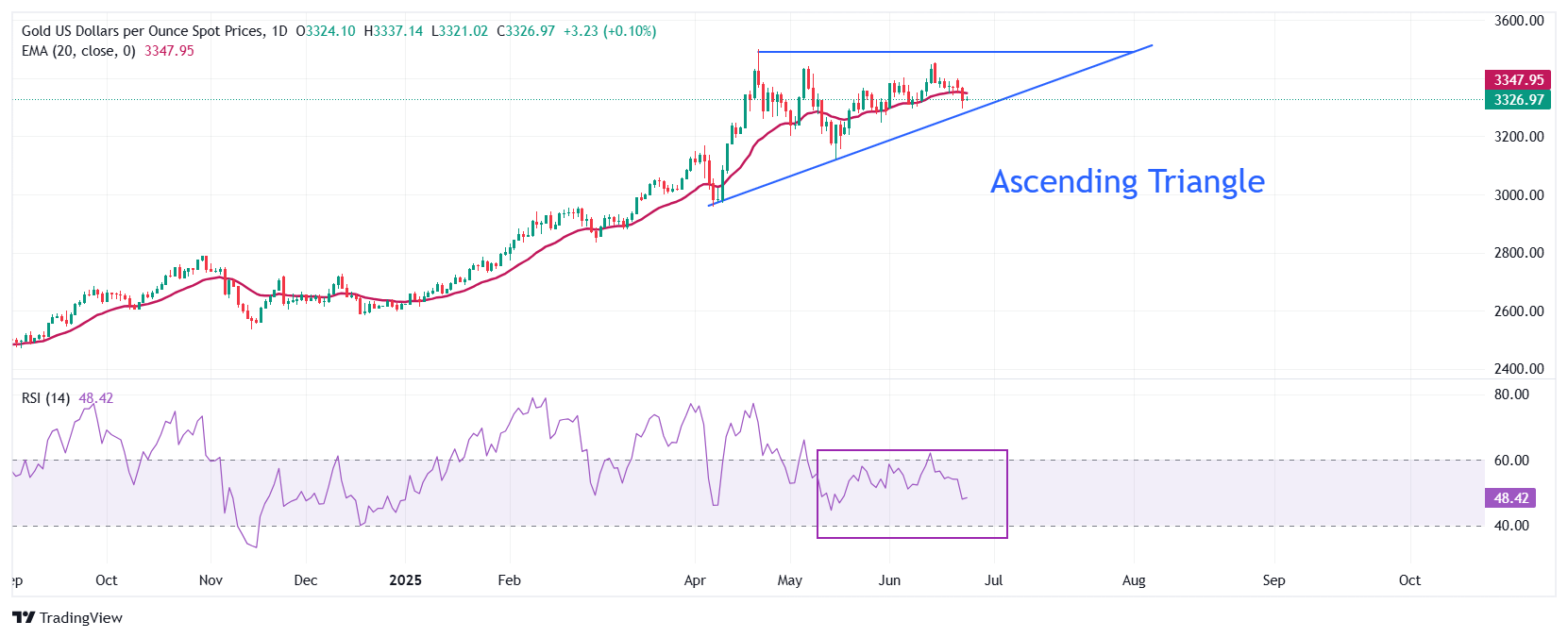- Gold price strives to gains ground while broader risk rally dampens safe-haven demand.
- The Israel-Iran ceasefire has strengthened investors’ risk appetite.
- Fed Powell stated on Tuesday that the current monetary policy is appropriate considering uncertainty surrounding the tariff policy.
Gold price (XAU/USD) consolidates around $3,325 during European trading hours on Wednesday. The precious metal wobbles inside the Tuesday’s trading range, while its outlook seems uncertain as investors continue to increase bets in riskier assets, following the announcement of a ceasefire between Israel and Iran on Tuesday.
Easing geopolitical tensions often lead to a decline in demand for safe-haven assets, such as Gold.
United States (US) President said in a post on Truth.Social on Wednesday the both Israel and Iran have agreed to a truce and urged them not to violate the same.
Meanwhile, the comments from Federal Reserve (Fed) Jerome Powell in his semi-annual testimony on Tuesday in which he dashed hopes of an interest rate cut in the July monetary policy meeting has also weigh on the Gold price.
Jerome Powell stated that the central bank is “well positioned to wait to learn more about the likely course of the economy before considering any adjustments to our policy stance”. Powell guided that the central bank will closely monitor the “impact of tariffs imposed by US President Trump on inflation through the June and July data”. He added that he will support interest rate cuts sooner if data suggests that the impact of tariffs on inflation is not as big as the Fed anticipated earlier.
Theoretically, higher interest rates by the Fed for a longer period bode poorly for non-yielding assets such as Gold.
Gold technical analysis
Gold price trades in an Ascending Triangle formation on a daily timeframe, which indicates volatility contraction. The horizontal resistance of the above-mentioned chart pattern is plotted from the April 22 high around $3,500, while the upward-sloping trendline is placed from the April 7 low of $2,957.
The precious metal trades below the 20-day Exponential Moving Average (EMA), suggesting that the near-term trend has turned bearish.
The 14-day Relative Strength Index (RSI) oscillates inside the 40.00-60.00 range, indicating a sideways trend.
Looking up, the Gold price would enter in an unchartered territory after breaking above the psychological level of $3,500 decisively. Potential resistances would be $3,550 and $3,600.
Alternatively, a downside move by the Gold price below the May 29 low of $3,245 would drag it towards the round-level support of $3,200, followed by the May 15 low at $3,121.
Gold daily chart

Gold FAQs
Gold has played a key role in human’s history as it has been widely used as a store of value and medium of exchange. Currently, apart from its shine and usage for jewelry, the precious metal is widely seen as a safe-haven asset, meaning that it is considered a good investment during turbulent times. Gold is also widely seen as a hedge against inflation and against depreciating currencies as it doesn’t rely on any specific issuer or government.
Central banks are the biggest Gold holders. In their aim to support their currencies in turbulent times, central banks tend to diversify their reserves and buy Gold to improve the perceived strength of the economy and the currency. High Gold reserves can be a source of trust for a country’s solvency. Central banks added 1,136 tonnes of Gold worth around $70 billion to their reserves in 2022, according to data from the World Gold Council. This is the highest yearly purchase since records began. Central banks from emerging economies such as China, India and Turkey are quickly increasing their Gold reserves.
Gold has an inverse correlation with the US Dollar and US Treasuries, which are both major reserve and safe-haven assets. When the Dollar depreciates, Gold tends to rise, enabling investors and central banks to diversify their assets in turbulent times. Gold is also inversely correlated with risk assets. A rally in the stock market tends to weaken Gold price, while sell-offs in riskier markets tend to favor the precious metal.
The price can move due to a wide range of factors. Geopolitical instability or fears of a deep recession can quickly make Gold price escalate due to its safe-haven status. As a yield-less asset, Gold tends to rise with lower interest rates, while higher cost of money usually weighs down on the yellow metal. Still, most moves depend on how the US Dollar (USD) behaves as the asset is priced in dollars (XAU/USD). A strong Dollar tends to keep the price of Gold controlled, whereas a weaker Dollar is likely to push Gold prices up.